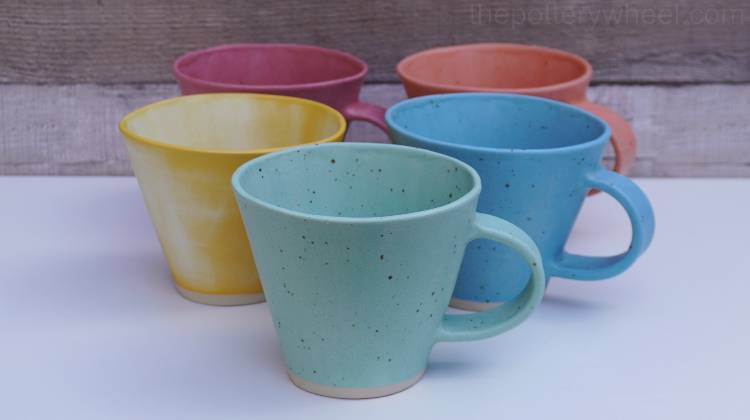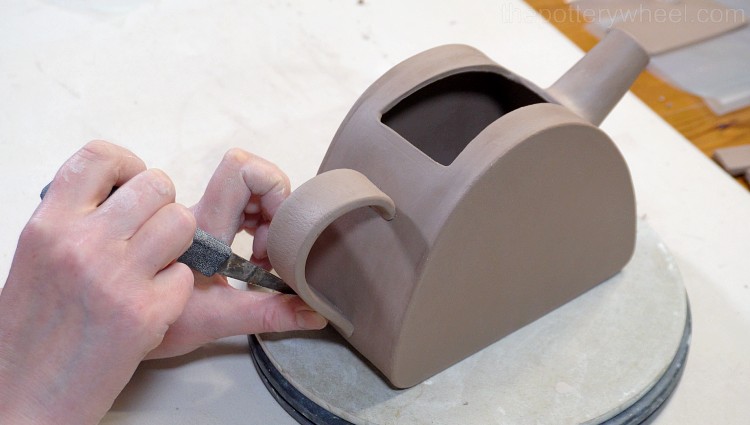The term ‘majolica’ has been used to refer to two different kinds of pottery. One type is tin-glazed pottery and its production is said to date back to the 8th century. The other is colorful lead glaze pottery which emerged in Victorian England. In spite of this difference, there are ways to identify majolica pottery, so, let’s take a look at those now.
Tin-glazed pottery is usually called maiolica, though it’s often called majolica too. The detailed designs are painted in oxides or enamels onto an opaque white tin glaze. Tin glaze pottery is usually flat. By contrast, Victorian majolica is relief molded pottery, painted with colorful glossy lead glazes. Its style is often described as naturalistic or whimsical.
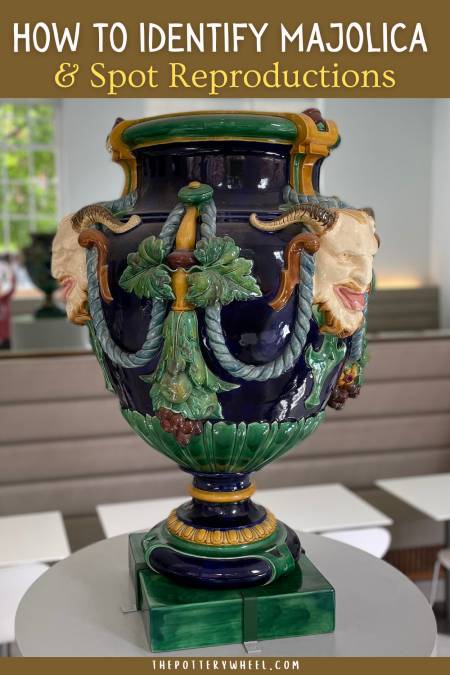
Having a clear idea of the difference between tin glazing and colored lead glazing will help you identify majolica. So, let’s start by taking a quick look at those differences…
Tin-Glazing and Colored Lead Glazing
Firstly, tin-glaze is actually a lead glaze. It’s just that a small amount of tin oxide has been added to it to make the glaze an opaque white color.
It’s thought that tin-glazing began in Mesopotamia in 750AD. But its popularity took off in 8th century Spain. Tin glazing was important because the white glaze was used to cover up colored local earthenware clay.
This clay was often buff, yellow, red, or brown. Tin glaze was applied to cover the colored clay. The white surface was then used like a blank canvas and decorations were painted onto that surface with oxides and stains. A clear glaze was sometimes applied over the painted decoration.
In 711AD Spain was conquered by the Moors who were from North Africa and Iberia. The Moorish influence on Spanish pottery is evident in the often Islamic style of decoration used on pottery at that time. This is often referred to as Hispano-Moresque pottery.
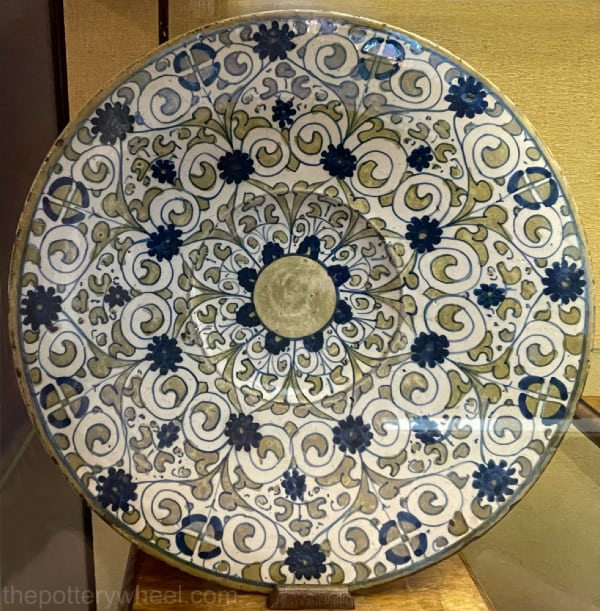
Inspired by the Decoration on Hispano-Moresque ceramics.
On display at The Wallace Collection.
A lot of Spanish pottery was exported around the world. It had particular influence in Italy where Italian tin-glazed pottery became a refined art. Italian tin-glazed pottery is usually called Maiolica, but it’s sometimes called majolica too.
Italian maiolica was at its height during the Renaissance which began in the 14th century. Nevertheless, some maiolica is still being made today in Italy.
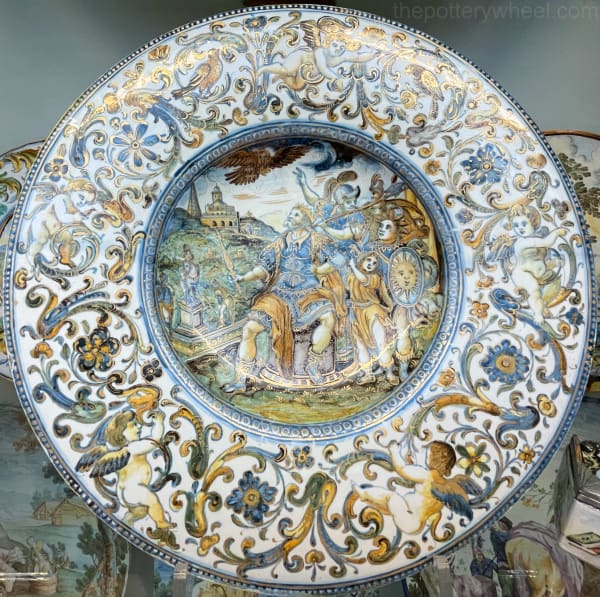
Over the centuries, the art of tin-glazing spread across the globe and different countries developed their own styles. They also devised their own names, for example, in the Netherlands it became known as Delftware. In France it was known as Faience, in England it was known as English Delft and in Germany, it was called Fayence.
Is Tin Glazing Maiolica or Majolica?
Tin-glazed pottery has often been called majolica. This is the anglicized version of the word maiolica, replacing the letter ‘i’ with the letter ‘j’. Tin-glazed English Delft pottery was made between from the late 16th century (source).
Its popularity began to wane around the 1770s as porcelain became more available. Also, around 1750 there was a growing interest in a lead-glazed earthenware called ‘creamware’(source).
Nevertheless, in 19th century tin-glazed pottery was being made by the well-known British ceramics producer Mintons. They were making tin-glazed pottery, often in the style of Italian Renaissance maiolica. Mintons called their tin-glazed ceramics majolica.
Colored Lead Glazed Majolica
In 1849 Mintons also started to develop another type of pottery that also came to be known as majolica. This was pottery that was made from molds and had textured relief surfaces.
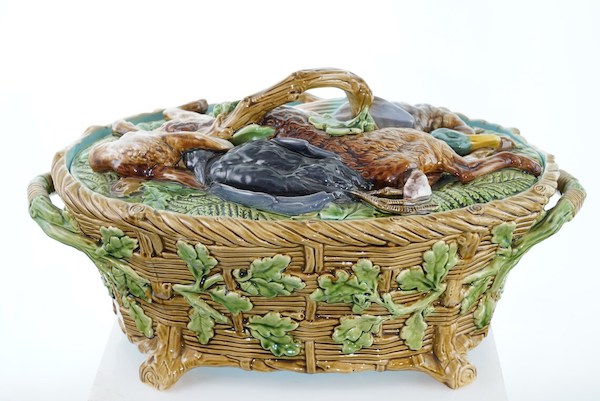
Image courtesy of Estate Fresh Austin
The reliefs were usually representations of natural themes. Some of the themes included foliage, flowers, and plants, whilst other pieces had a gothic look. Inspiration was also taken from the natural sciences. At the time there was a fascination with Darwin’s theory of evolution, and art often reflected these themes.
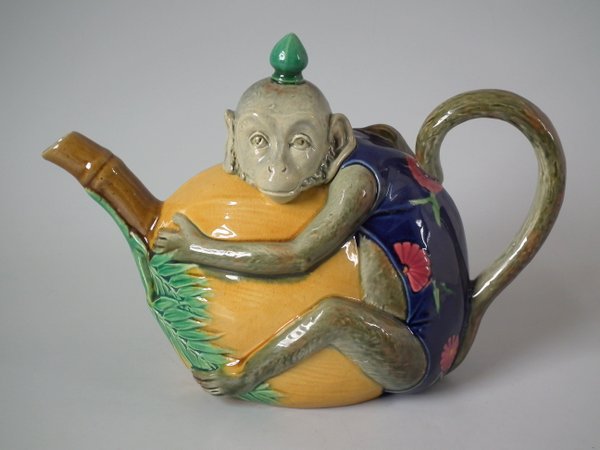
In 1851 Mintons launched this new range of majolica at the Great Exhibition in London, England. At the time it was launched under the name of Palissy Ware, after the French ceramicist Bernard Palissy. But Minton quickly started to refer to it as Majolica, and since then it has been referred to as Victorian Majolica.
With Victorian majolica, bare ceramic pottery, called bisque ware was painted with colorful lead glazes. Different colors were applied at the same time, and then the piece was fired in a kiln a second time. This produced glossy, colorful pieces of textured ceramic ware.
Now that we’ve covered the difference between tin-glazed and Victorian lead-glazed majolica, let’s take a look at how to identify both of them. We start with identifying tin-glazed earthenware as this type of pottery appeared earlier in history.
How to Identify Tin-Glazed Majolica
Whether you refer to tin-glaze pottery as maiolica or majolica depends to an extent on your location. In the US and the UK, maiolica is often referred to as majolica.
Tin glazed earthenware was produced by many countries each with its own distinct decorative style. For the purposes of this article, I’ll consider Italian maiolica as Italy has been such a prolific producer of maiolica.
Spotting Antique Maiolica
Here are some features to look out for:
1) The Style
At its peak, Italian maiolica had what is called an ‘istoriato’ style. The paintings on the pottery told a story, and these stories were usually historical, biblical, or mythological.
Sometimes the scene would be painted on the center of the plate, with an ornate border painted around the picture. Often the design would cover the whole surface of the plate (source).
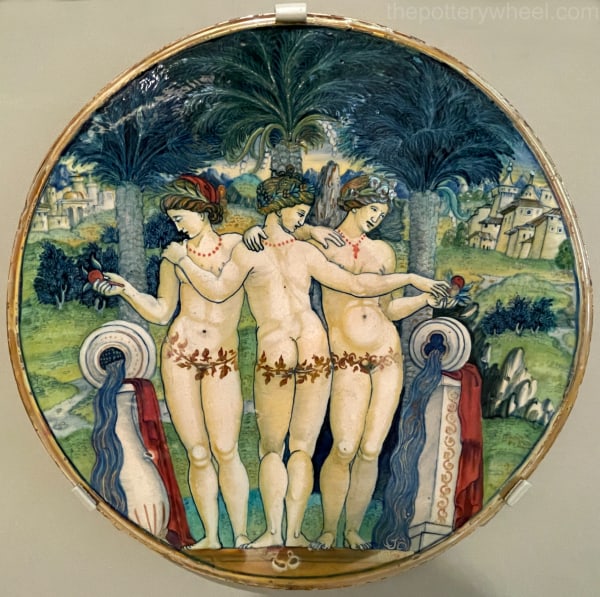
2) Precision and Detail
Italian maiolica makers developed a very precise detailed style of painting their pottery. The brushwork was incredibly refined.
3) Color Palette
The colors used on Italian maiolica often feature blues, greens, various shades of brown, oranges, yellows, and violets. These were all painted on the white tin-glaze base. Sometimes luster glazes were used to add metallic highlights to the design.
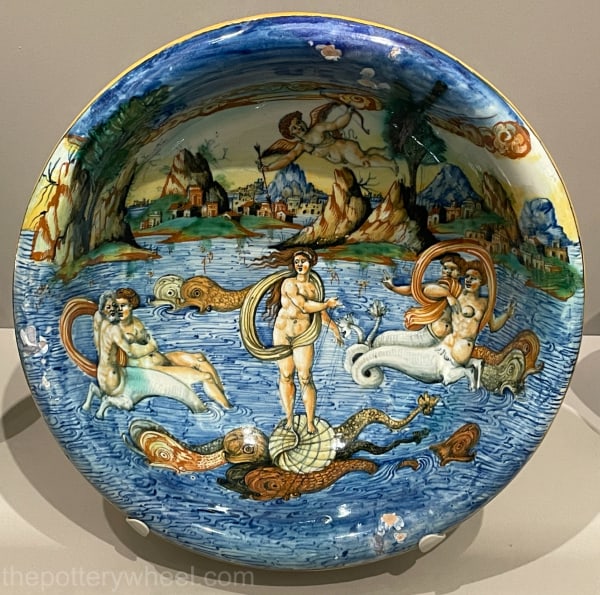
4) The Profile
The surfaces of Italian maiolica is usually flat rather than engraved or with relief designs.
5) The Clay Body
Because Italian maiolica is made from earthenware clay, you will see the colored clay body beneath the white tin glaze. The colored earthenware clay will be visible on the foot ring or underneath any chips or damage on the pottery glaze.
The color of the clay body will depend on the region that the clay is from. However, on antique maiolica, the exposed clay will be discolored with age.
6) Markings
If you turn the piece over and look at the base, you may see the maker’s marks on the underneath. Pottery markings are not the be-all and end-all when you want to identify majolica or maiolica. Not all pieces were marked, and just because a piece is not marked this doesn’t mean that it is not authentic.
For example, the plate below is a tin-glazed Italian dish from around 1420, it has an unmarked base.
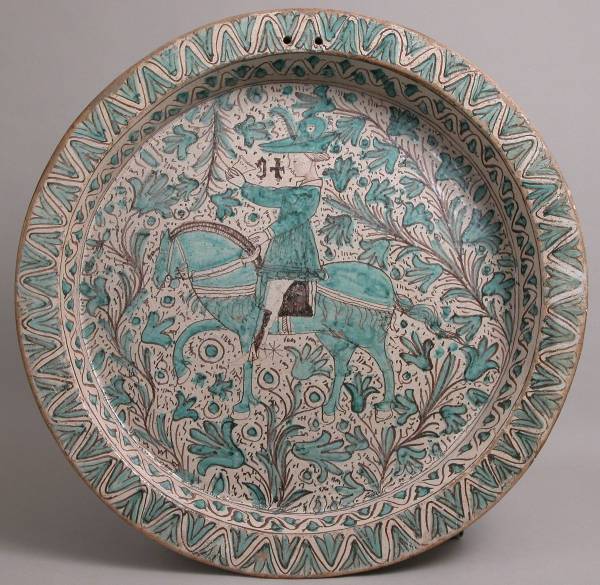
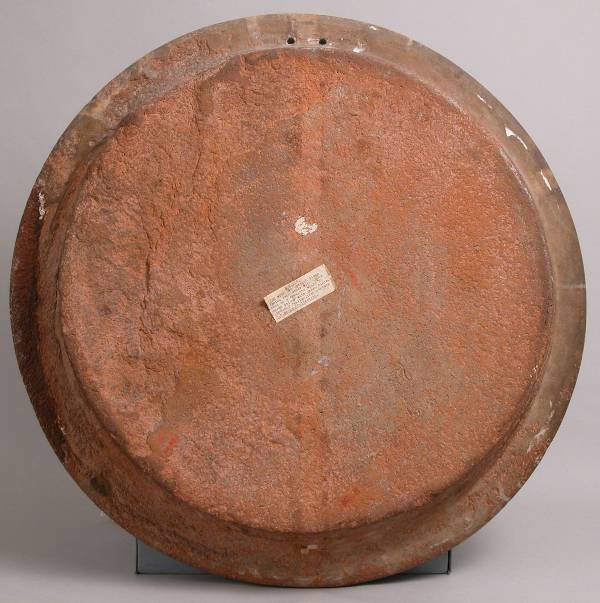
Image courtesy of The Met.
When Italian maiolica is marked, it can include all or some of the following details:
- The painter’s name or initials
- Title of the subject matter painted on the pottery
- The shop that the painter worked for
- The name of the master that owned and ran the pottery
Some pieces of maiolica will have all of this information, and the markings underneath will be comprehensive. Other pieces will just feature one or two bits of information, in particular the title of the painting on the piece.
Here are some examples of markings found on the underside of Italian maiolica pieces. This first plate dated 1542, has both the date, the title of the painting, and the workshop in which it was made.
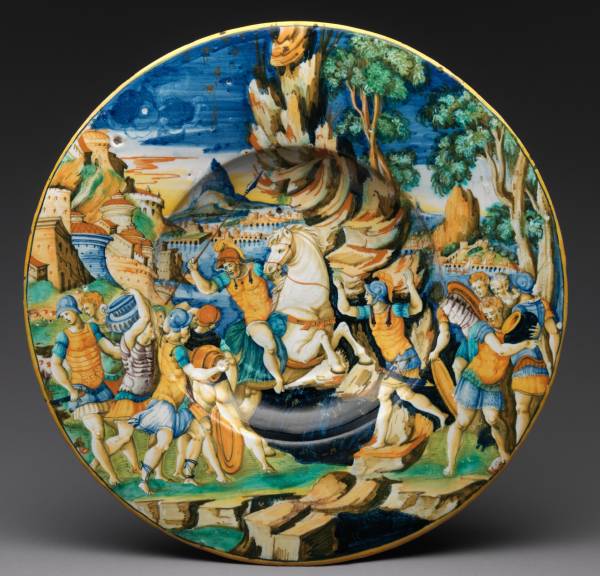
Image courtesy of The Met. Public Domain
Here is the inscription on the reverse of the above plate:
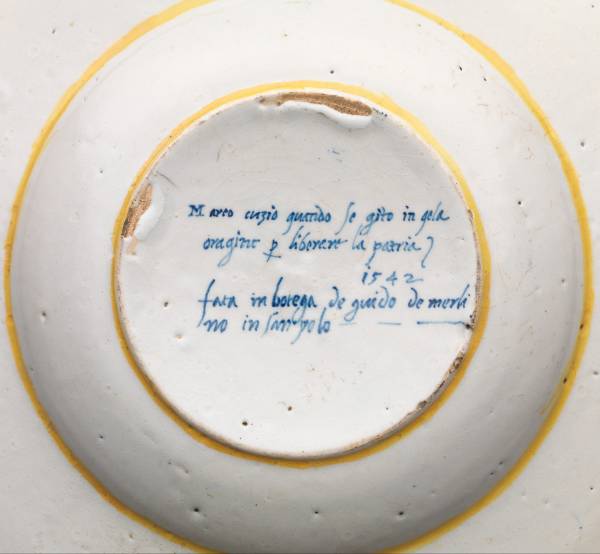
Made in the workshop of Guido di Merlino in San Polo”.
Image courtesy of The Met. Public Domain.
This second plate has partial information inscribed on the reverse, which includes the title of the painting.
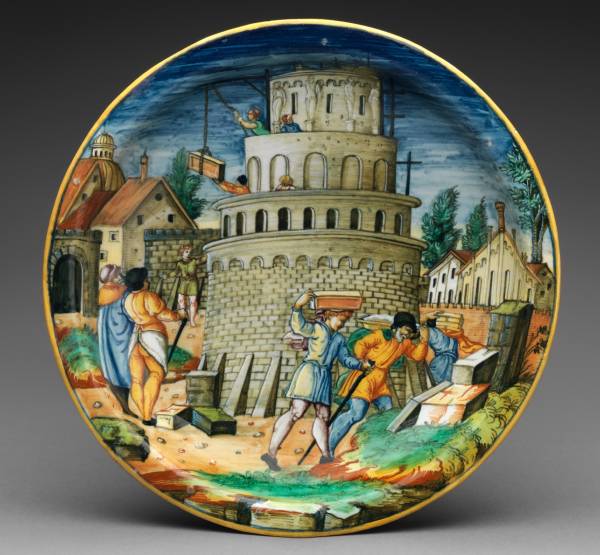
Image Courtesy of The Met. Public Domain.
Here is the inscription on the reverse of the above plate:
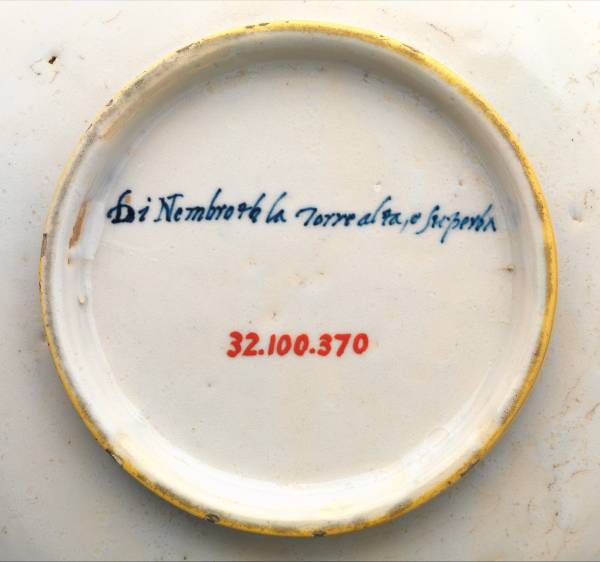
How to Identify Victorian Majolica
Victorian majolica is a style of lead-glazed earthenware that originates from England in 1849. Mintons had been experimenting with colored lead glazes for a few years before they publicly launched their new majolica range in 1851.
Although Minton called this new style of pottery majolica, it was different from the tin-glazed ware that had been produced before.
The way that Victorian majolica was made was quite different from tin-glazed pottery. And also, the style and look of lead-glazed majolica was different. Let’s look at some of these features, so you know what to look out for if you want to identify Victorian majolica.
1) Themes and Styles
There are lots of different themes present in Victorian majolica. The subjects can range from peacocks to cherubs and gargoyles. One theme that comes up a lot in majolica pottery is the natural world.
There is a focus on flowers, plants, animals, and nature. Sometimes these are botanical themes, and at other times they echo the Victorian fascination with evolution.
For example, there are lines of majolica pottery dedicated to corn, asparagus, cabbage leaves, cauliflowers, birds, monkeys, and more.
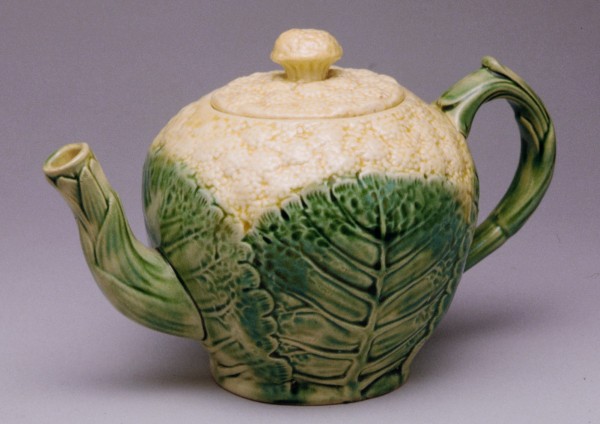
Image Courtesy of The Met. Public Domain.
Some of the influences seen in Majolica pottery are, amongst other things, gothic, oriental, Egyptian, and imperial France.
The majolica technique was used to make all sorts of different items. Majolica pieces will range from small dishes designed for the dining table to large planters, beautifully painted jardinerres, and ornate garden furniture.
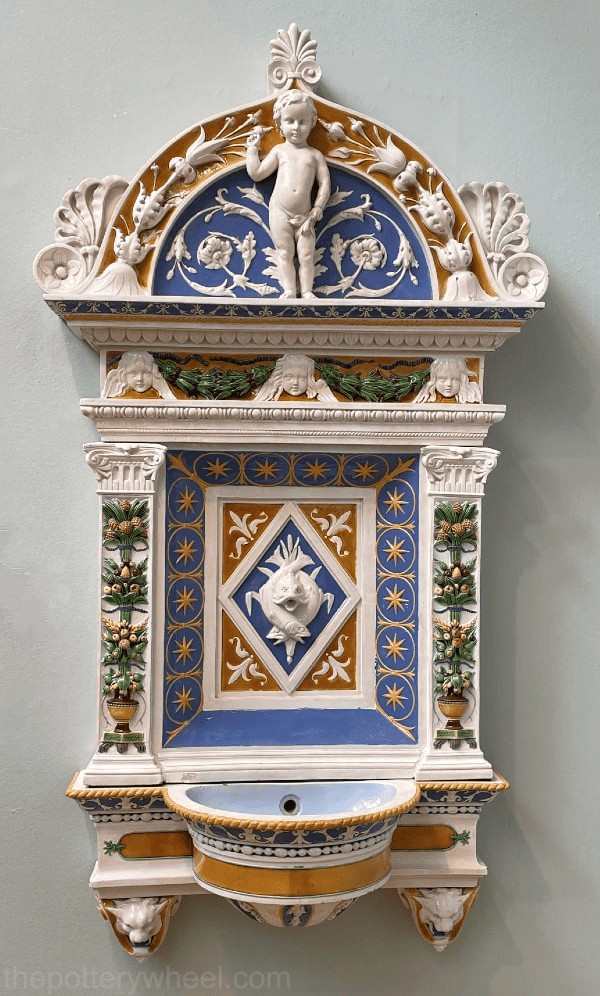
On display at The V&A.
2) Relief Designs
Rather than being flat or having a flush surface, Victorian majolica usually has molded relief designs.
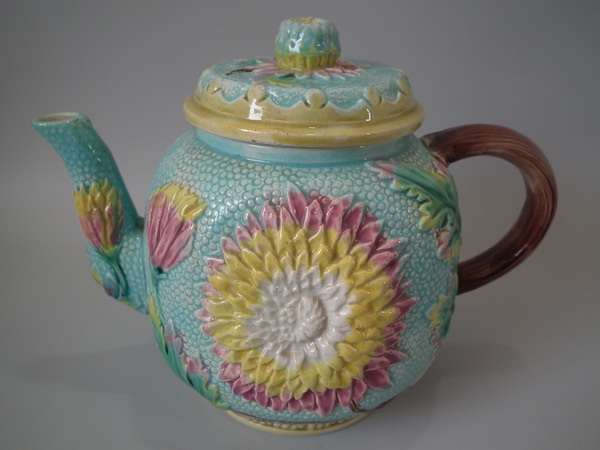
Image by Davidmadelena
CC BY-SA 4.0. Via Wikimedia Commons
Plaster molds were made of the original piece, and then multiple copies of the original work could be made. The molding process involved pressing strips of clay into the mold. These molds were therefore called press molds.
Once the clay had firmed up, it could be removed from the mold and the different pieces of clay that made up the item could be joined together using slip and score. This was then fired in a kiln before being glazed.
One way to identify reproduction or fake majolica is to look at the inside surface of the pot. If you can see the details or textures of the pattern showing through on the inside surface, you need to question if the piece is authentic (source – Antique Trader Guide to Fakes and Reproductions)
The texture shows up on the inside surface of a fake piece because of the production process. A cheaper and easier way to produce majolica is to use a process called slip casting, where liquid clay is poured into a mold and allowed to firm up.
When a press mold is used, the clay forms a substantial layer and any bumps and marks are smoothed off. The dish below shows the smooth inside of an authentic Minton majolica dish.
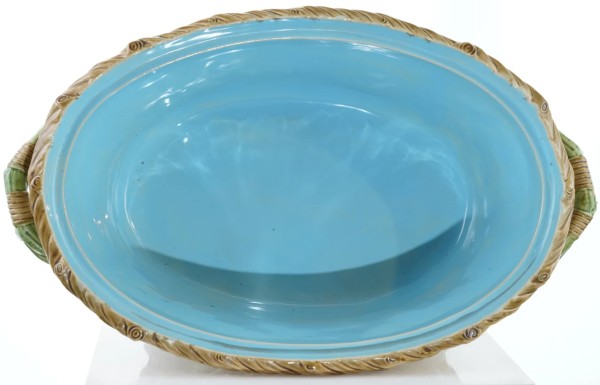
Image courtesy of EstateFreshAustin.
By contrast, slip casting tends to reveal the underlying texture of the mold on the inside surface. For example, you can see the texture of the design on the inside surface of this inexpensively produced reproduction majolica in this picture.
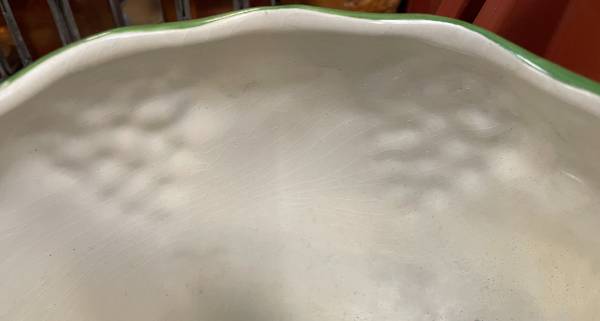
3) Colorful Glazes
Colored lead glazes were painted onto bisque pottery in the process of making Victorian majolica. These glazes had been carefully designed to be fired together without running into one another or dripping.
Different majolica manufacturers used their own color palettes that became associated with their products. But generally speaking, the glazes used on majolica were colorful and rich without being gaudy.
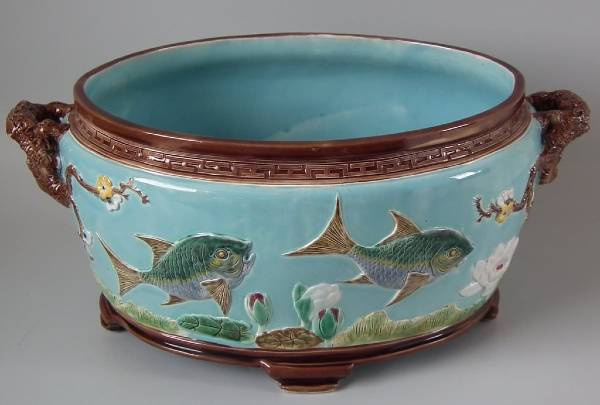
Davidmadelena (CC BY-SA 4.0) Via Wikimedia Commons.
You can use the glazes to help you identify majolica in a couple of ways. Firstly, check how well the glaze was applied. A lot of majolica was made in ceramics factories, and decorated by workers who had been employed as painters (source). The pieces were mass produced and the painters were working on a production line.
Nevertheless, the glazes painted on authentic majolica were carefully applied. And, in spite of the factory setting, the glaze normally follows the lines of the mold and is generally where it’s supposed to be.
Reproduction and fake majolica will often have the look of having been decorated quickly and with little precision.
Another thing to look out for is glaze that is excessively runny or a lot of glaze drips. Glazing is a tricky process, and you may find the occasional glaze drip on authentic majolica. But if the piece is very sloppy with a lot of drips and glazes bleeding into one another a lot, then there is a good chance that the piece is a fake.
4) Signs of Age
Earthenware pottery is relatively soft. Unlike other ceramic materials like porcelain or stoneware, it is still a bit porous, even when it’s been fired. This makes it vulnerable to being chipped with time.
For that reason, antique majolica may well have some chips and nibbles in the glaze and on its edges. Minor damage like this doesn’t affect the value of a piece too much. If a piece of pottery has significant damage like a broken handle or a missing piece, then the value will be compromised. But a bit of chipping here and there is not too much to worry about.
Another feature of antique majolica will be that the glaze may have a little crazing on it. Crazing is a network of fine cracks that spread across the glaze. Again, this won’t necessarily affect the value of the piece as crazing is more or less inevitable on antique earthenware.
In fact, these signs of age are a good indicator that the piece you are looking at is authentic. If you have a piece of pottery that is in pristine condition this may be a sign that the pottery in question is a modern reproduction.
5) The Color of the Clay
Earthenware clay is usually an off-white color. Unlike porcelain which can have a pure white, sometimes translucent quality, earthenware is earthier.
The base of a piece of antique majolica will probably be glazed. However, the foot ring, which is the bit that the pottery rests on will be unglazed. You will see the color of the clay on the foot ring, which is likely a creamy, off-white color.
It’s worth noting that the foot ring of an antique will likely be discolored. Dust, debris, and moisture are absorbed into the porous earthenware clay over the years causing some discoloration.
If you turn the piece over and the clay is very white and does not look discolored in any way, there is a good chance that it was made recently and is not an antique.
6) Majolica Pottery Marks
Another helpful way to identify majolica is to have a look at the base for any pottery marks that were made by the manufacturer. Each majolica manufacturer had their own way of marking the pieces they made, and this can help identify who produced it.
British Majolica Manufacturers
Here are some examples of pottery marks used by important majolica manufacturers.
Minton Majolica
Mintons were the original manufacturers of Victorian British majolica and they were systematic about marking their pottery. Sometimes the mark is a little concealed by pottery glaze, but closer inspection will reveal at least the name “MINTON” impressed in the clay.
Mintons used a series of symbols to indicate the year that a piece of pottery was made. Here is a list of the marks they used between 1842 and 1942.
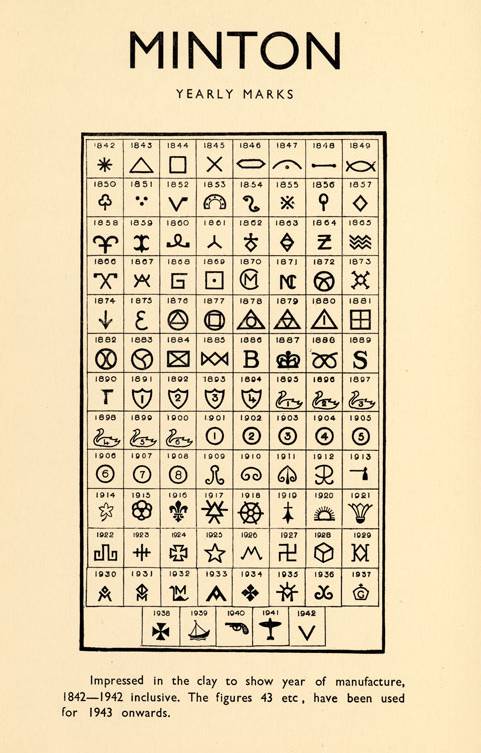
In 1851, the year they formally introduced their majolica ware to the public, they started to print the word MINTON onto their ware. And, in 1873, this changed to MINTONS, with an ‘S’ on the end.
In addition to this, Minton also sometimes used a number to refer to the shape of a piece. On the piece below, that number is 1522. Other marks might include the month it was made and the maker’s mark.
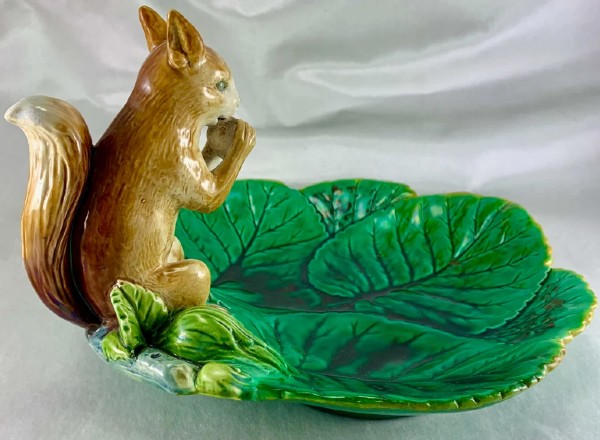
Image courtesy of Mosaic Modes and Curios
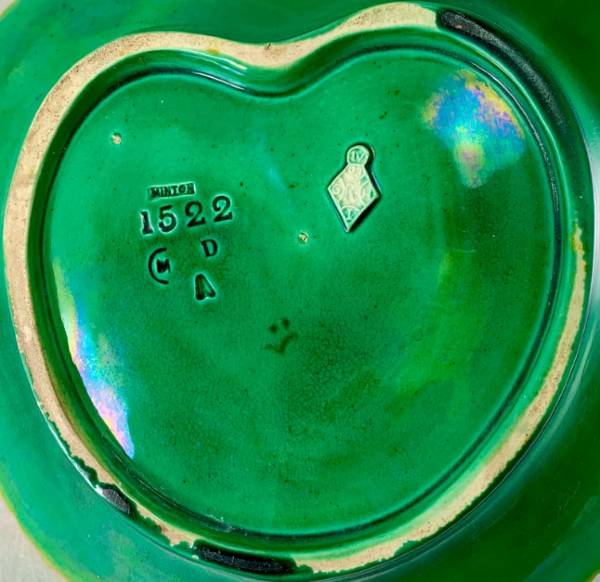
Image courtesy of Mosaic Modes and Curios
If you look at the base of the trinket dish, you can see a symbol that looks like a semi-circle with an M in it. Referring to the chart of Minton Yearly Marks above, we see that this indicates the dish was made in 1870.
To the right of the pottery marks is the diamond-shaped symbol that indicates that the design had been registered with the British Patent Office. The letters on this registration mark indicate that the design of this dish was registered on the 23rd of July 1869.
Wedgwood Majolica
In 1860, the Wedgwood factory began to use three letters to indicate the date the piece was made.
With the three-letter system, the first letter indicates the month of manufacture, the second letter indicates the potter and the third letter indicates the year. Wedgwood used the letter O to start the sequence in 1860 and repeated the use of the letters of the alphabet.
Here are a couple of handy graphics to help you identify when a piece of Wedgwood majolica was made:
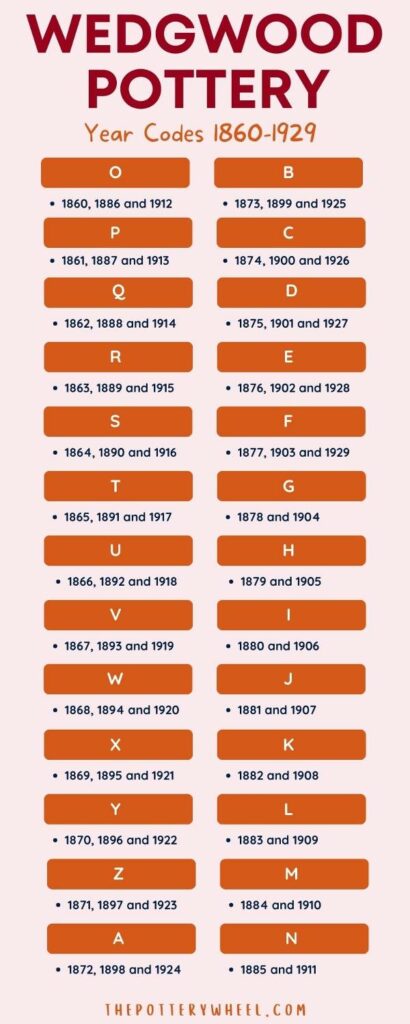

You can see on this plate below that, in addition to being stamped with the name Wedgwood, it is also marked with the letters FUR. Because letters of the alphabet were used more than once to represent the year of manufacture, there can be some confusion about the date a piece was made (source).
However, in 1891 they started to impress ‘ENGLAND’ on the piece too. And, ‘MADE IN ENGLAND’ was used from 1908. This would suggest that the plate below was made in February in either 1863 or 1889 as the letter R was used to represent both of these years of production.
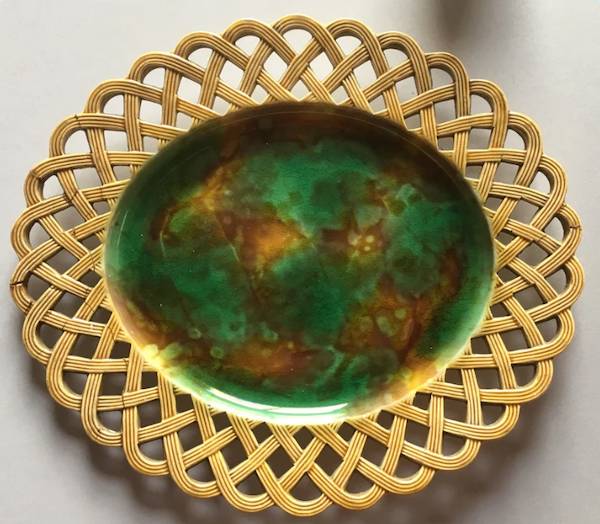
Image courtesy of Albion Antiques.
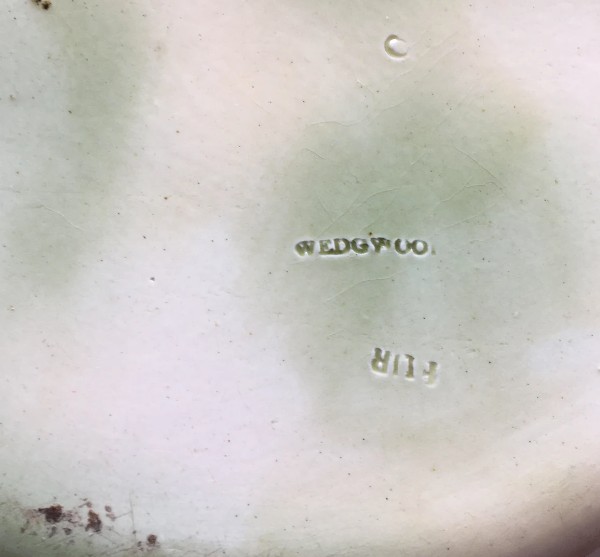
Image courtesy of Albion Antiques
George Jones Majolica
The early George Jones majolica pottery mark consisted of the two letters GJ superimposed on top of one another. If you look at the picture below, you can see these letters on the bottom half of the picture underneath the diamond-shaped registration mark.
Later on, in 1873, the mark was adjusted to include the words ‘& sons’ in a crescent shape underneath the monogram GJ.
Other George Jones marks include a small patch of unglazed pottery on the base. The pattern number of the piece was written on this unglazed area in black ceramic stain.
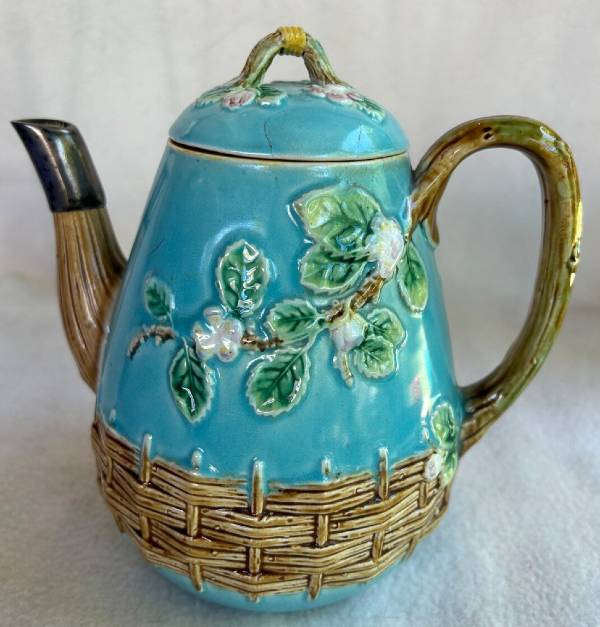
Image courtesy of TwoBizzarrePeople
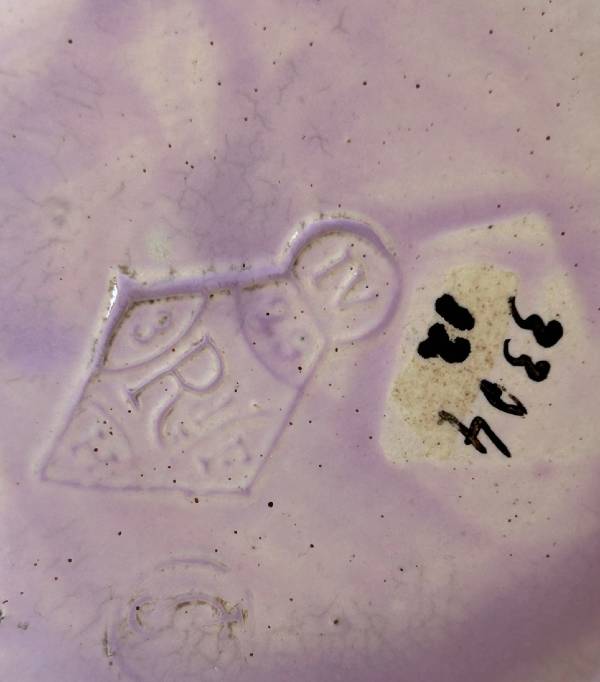
Image courtesy of TwoBizzarePeople
The registration diamond on this piece of George Jones majolica indicates that the design was registered on the 29th of April 1873.
Holdcroft Majolica
Not all pieces of majolica were marked, so pottery marks are not a foolproof way of identifying majolica.
For example, whilst Minton, Wedgwood, and George Jones were quite systematic in marking their pottery, another important English manufacturer Joseph Holdcroft did not mark a lot of his ware.
Here is an example of a Holdcroft piece that was marked.
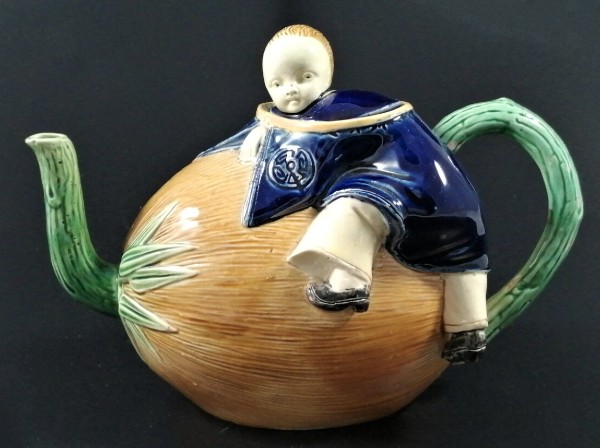
Image courtesy of Gillers Antiques
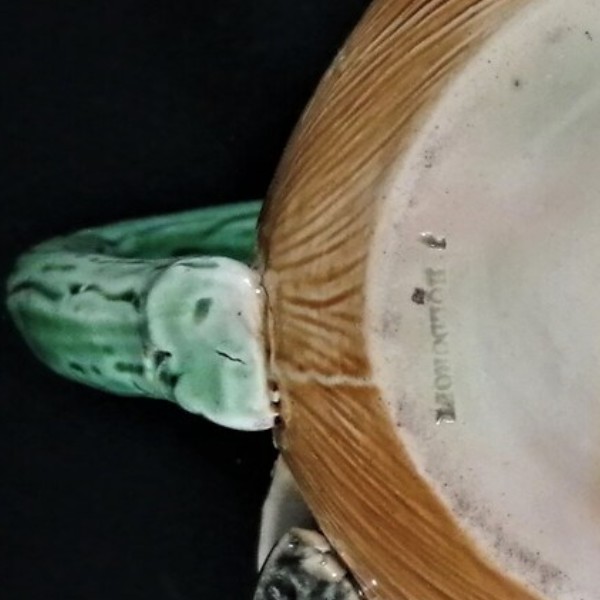
Image courtesy of Gillers Antiques
American Majolica Manufacturers
The biggest and most well-known American majolica manufacturers were Griffen, Smith, and Hill. They began producing majolica in 1879 and their majolica is often called Etruscan ware.
Griffen, Smith, and Hill
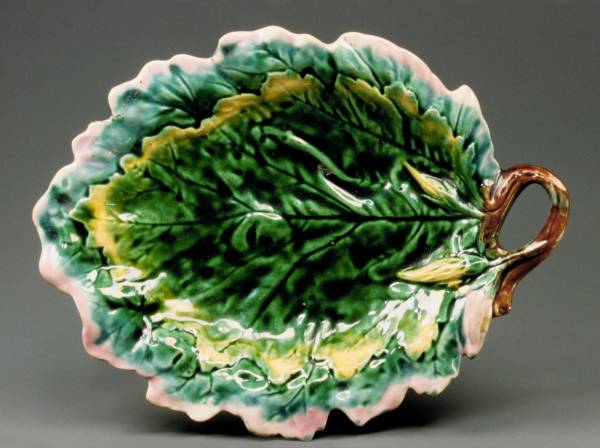
Image courtesy of The Met. Public Domain.
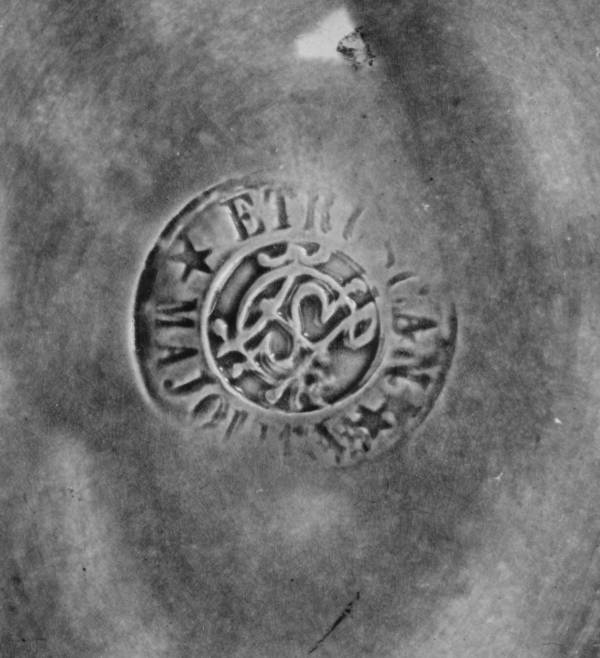
Image courtesy of The Met. Public Domain.
Chesapeake Pottery
The Chesapeake Pottery based in Baltimore started to make majolica in 1882. One of their lines was the Avalon Faience line. This line was unusual for majolica because it was monochrome, with gold highlights.
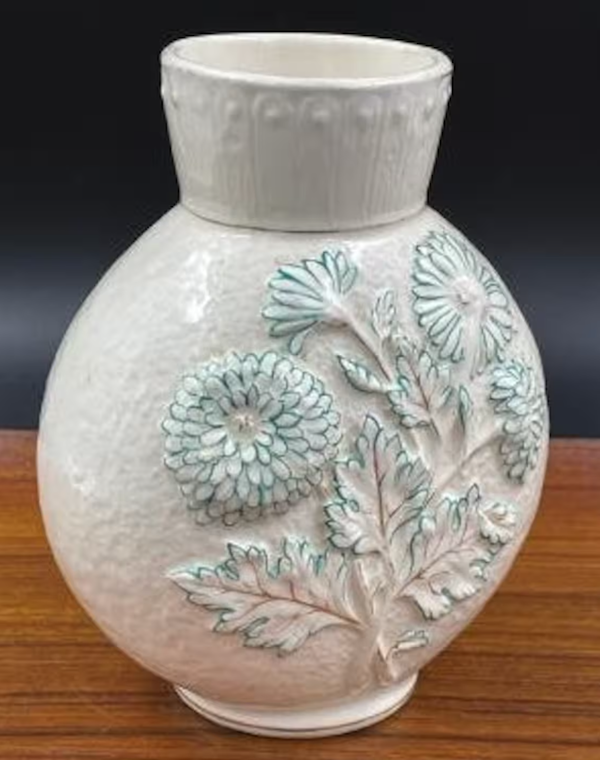
Image courtesy of Retro Vintage Monkey
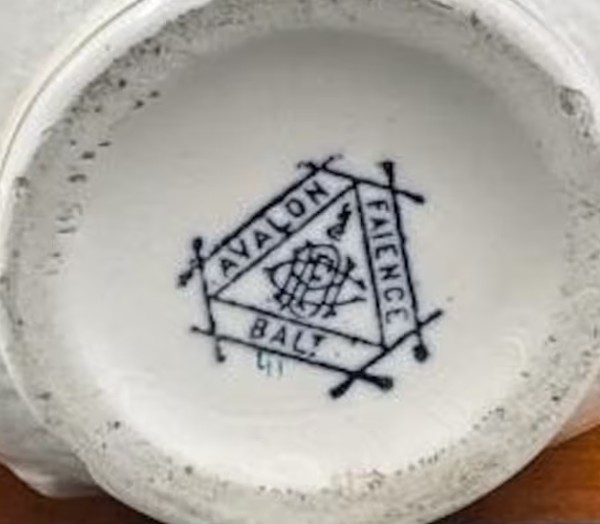
Image courtesy of Retro Vintage Monkey
How to Identify Changing Majolica Pottery Marks
It’s worth noting that manufacturers changed the marks that they used over the years. This means that their mark may look different according to the time the piece was produced. Familiarising yourself with the different marks they may have used is a good way to begin to identify majolica.
Another factor that affects the usefulness of pottery marks is that fake marks are sometimes used in reproductions. This can make it harder to identify genuine majolica.
In 1970 there was a resurgence of interest in Victorian majolica and a significant number of reproductions were made.
Some reproductions are clearly marked as such, and not intended to deceive. But others are mass-produced fakes, intended to cash in on the growing popularity.
Manufacturers with either impress, emboss, or print the mark onto the base. If you find a piece of majolica that bears a mark, familiarize yourself with the marks that the manufacturer typically used.
You can usually search the internet to find examples of the marks each manufacturer used. Compare the mark on the base of the piece you are interested in and see how they measure up.
Having said that, even if the mark does look genuine, it’s important to take all the other identifying factors mentioned above into account. Another way to assess the authenticity is to evaluate the overall quality of the piece. So, let’s take a look at that factor now.
7) Overall Quality
If you are able to hold the pottery, you will get a feel of the overall quality of the piece. It’s often said that authentic antique majolica is heavier than lighter-weight reproductions.
In some cases this is true. Modern factory-made reproductions may have been made using lighter bisque pottery. However, the weight of an item is not an absolute indicator. Some reproductions and fakes will be quite solid.
However, one tell-tale sign of whether a piece is authentic is to look at the quality of the details. For example, is the handle on the pottery solid or hollow? Genuine antique majolica will have a solid handle. This is because the handle was made separately and attached to the pot once the clay had been released from its mold.
If you find a job lot of items at a flea market, that look like majolica, but that are going at a very low price, they are probably reproduction. When an item or items are priced very low, they are unlikely to be antique.
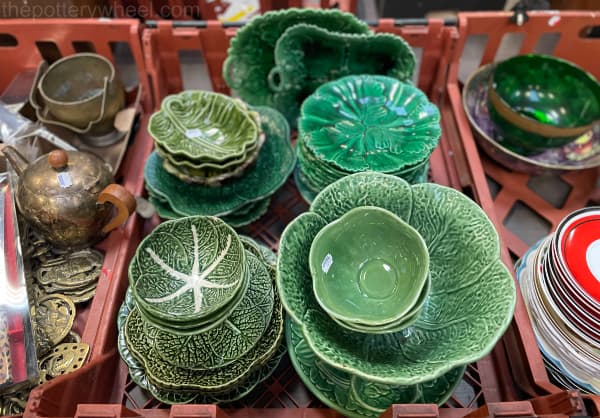
When reproductions are made by pouring clay slip into a mold, the handle and other details on the pot will be part of the mold. As a result, handles and apparently modeled details will be hollow rather than solid.
How to Identify Fake Majolica Pottery – A Summary
To summarize some of the things to look out for when trying to spot fake or reproduction majolica, keep an eye out for the following:
- Very white clay clearly showing on the base of the piece, particularly if this is very clean and shows no signs of age or wear.
- Glaze that looks as if it has been applied hastily and which may have a lot of drips or runs. It’s worth remembering that some authentic manufacturers took to applying glaze to their majolica in a looser style. So, imperfect glaze application may not indicate that the piece is a reproduction. However, excessive glaze running is normally something to be wary of.
- Very bright primary colors that border on being harsh or garish.
- Poor quality craftsmanship.
- The use of fake pottery marks.
Final Thoughts
The term majolica has been used broadly and there has been some confusion about what it means. However, whether you want to find antique Italian maiolica or Victorian majolica the features outlined above will, I hope, help you to identify it.
That being said, probably the best thing to do is to become as familiar as you can with what majolica looks like. Reading books, visiting galleries, antique dealers and museums will help you to hone your ability to spot the real thing when you see it.


